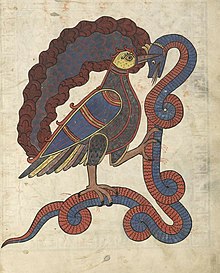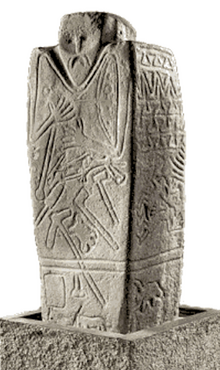Proto-Indo-European mythology
This article should specify the language of its non-English content, using {{lang}}, {{transliteration}} for transliterated languages, and {{IPA}} for phonetic transcriptions, with an appropriate ISO 639 code. Wikipedia's multilingual support templates may also be used. (October 2021) |
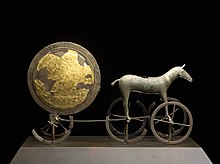
| Part of a series on |
| Indo-European topics |
|---|
 |
| Mythology |
|---|
Proto-Indo-European mythology is the body of
The Proto-Indo-European
Some myths are also securely dated to Proto-Indo-European times, since they feature both linguistic and thematic evidence of an inherited motif: a story portraying a
Various schools of thought exist regarding possible interpretations of the reconstructed Proto-Indo-European mythology. The main mythologies used in comparative reconstruction are
Methods of reconstruction
Schools of thought
The mythology of the Proto-Indo-Europeans is not directly attested and it is difficult to match their language to archaeological findings related to any specific culture from the

The Meteorological or Naturist School holds that Proto-Indo-European myths initially emerged as explanations for natural phenomena, such as the Sky, the Sun, the Moon, and the Dawn.[5] Rituals were therefore centered around the worship of those elemental deities.[6] This interpretation was popular among early scholars, such as Friedrich Max Müller, who saw all myths as fundamentally solar allegories.[4] Although recently revived by some scholars like Jean Haudry and Martin L. West,[7][8] this school lost most of its scholarly support in the late nineteenth and early twentieth centuries.[9][6]
The Ritual School, which first became prominent in the late nineteenth century, holds that Proto-Indo-European myths are best understood as stories invented to explain various rituals and religious practices.[10][9] Scholars of the Ritual School argue that those rituals should be interpreted as attempts to manipulate the universe in order to obtain its favours.[5] This interpretation reached the height of its popularity during the early twentieth century,[11] and many of its most prominent early proponents, such as James George Frazer and Jane Ellen Harrison, were classical scholars.[12] Bruce Lincoln, a contemporary member of the Ritual School, argues for instance that the Proto-Indo-Europeans believed that every sacrifice was a reenactment of the original sacrifice performed by the founder of the human race on his twin brother.[10]
The Functionalist School, by contrast, holds that myths served as stories reinforcing social behaviours through the
The Structuralist School argues that Proto-Indo-European mythology was largely centered around the concept of
Source mythologies

- Center: Steppe cultures
- 1 (black): Anatolian languages (archaic PIE)
- 2 (black): Afanasievo culture (early PIE)
- 3 (black) Yamnaya culture expansion (Pontic-Caspian steppe, Danube Valley) (late PIE)
- 4A (black): Western Corded Ware
- 4B-C (blue & dark blue): Bell Beaker; adopted by Indo-European speakers
- 5A-B (red): Eastern Corded ware
- 5C (red): Sintashta (proto-Indo-Iranian)
- 6 (magenta): Andronovo
- 7A (purple): Indo-Aryans (Mittani)
- 7B (purple): Indo-Aryans (India)
- [NN] (dark yellow): proto-Balto-Slavic
- 8 (grey): Greek
- 9 (yellow): Iranian
- [not drawn]: Armenian, expanding from western steppe
One of the earliest attested and thus one of the most important of all Indo-European mythologies is
Another of the most important source mythologies for comparative research is Roman mythology.[20][22] The Romans possessed a very complex mythological system, parts of which have been preserved through the characteristic Roman tendency to rationalize their myths into historical accounts.[23] Despite its relatively late attestation, Norse mythology is still considered one of the three most important of the Indo-European mythologies for comparative research,[20] due to the vast bulk of surviving Icelandic material.[22]
Baltic mythology has also received a great deal of scholarly attention, as it is linguistically the most conservative and archaic of all surviving branches, but has so far remained frustrating to researchers because the sources are so comparatively late.[24] Nonetheless, Latvian folk songs are seen as a major source of information in the process of reconstructing Proto-Indo-European myth.[25] Despite the popularity of Greek mythology in western culture,[26] Greek mythology is generally seen as having little importance in comparative mythology due to the heavy influence of Pre-Greek and Near Eastern cultures, which overwhelms what little Indo-European material can be extracted from it.[27] Consequently, Greek mythology received minimal scholarly attention until the first decade of the 21st century.[20]
Although Scythians are considered relatively conservative in regards to Proto-Indo-European cultures, retaining a similar lifestyle and culture,[28] their mythology has very rarely been examined in an Indo-European context and infrequently discussed in regards to the nature of the ancestral Indo-European mythology. At least three deities, Tabiti, Papaios and Api, are generally interpreted as having Indo-European origins,[29][30] while the remaining have seen more disparate interpretations. Influence from Siberian, Turkic and even Near Eastern beliefs, on the other hand, are more widely discussed in literature.[31][32][33]
Cosmology
There was a fundamental opposition between the never-aging gods dwelling above in the skies and the mortal humans living beneath on earth.
Cosmogony
Reconstruction
There is no scholarly consensus as to which of the variants is the most accurate reconstruction of the Proto-Indo-European cosmogonic myth.
Creation myth
Lincoln reconstructs a creation myth involving twin brothers, *Manu- ("Man") and *Yemo- ("Twin"), as the progenitors of the world and humankind, and a hero named *Trito ("Third") who ensured the continuity of the original sacrifice.[42][43][44] Regarding the primordial state that may have preceded the creation process, West notes that the Vedic, Norse and, at least partially, the Greek traditions give evidence of an era when the cosmological elements were absent, with similar formula insisting on their non-existence: "neither non-being was nor being was at that time; there was not the air, nor the heaven beyond it" (Rigveda), "there was not sand nor sea nor the cool waves; earth was nowhere nor heaven above; Ginnungagap there was, but grass nowhere" (Völuspá), "there was Chasm and Night and dark Erebos at first, and broad Tartarus, but earth nor air nor heaven there was" (The Birds).[45][46]
In the creation myth, the first man Manu and his giant twin Yemo are crossing the

To the third man Trito, the celestial gods then offer cattle as a divine gift, which is stolen by a three-headed serpent named *Ngʷhi ("serpent"; and the Indo-European root for negation[50]). Trito first suffers at his hands, but the hero eventually manages to overcome the monster, fortified by an intoxicating drink and aided by the Sky-Father. He eventually gives the recovered cattle back to a priest for it to be properly sacrificed.[51][43] Trito is now the first warrior, maintaining through his heroic actions the cycle of mutual giving between gods and mortals.[52][43]
Interpretations
According to Lincoln, Manu and Yemo seem to be the protagonists of "a myth of the sovereign function, establishing the model for later priests and kings", while the legend of Trito should be interpreted as "a myth of the warrior function, establishing the model for all later men of arms".[52] The myth indeed recalls the Dumézilian tripartition of the cosmos between the priest (in both his magical and legal aspects), the warrior (the Third Man), and the herder (the cow).[43]
The story of Trito served as a model for later cattle raiding epic myths and most likely as a moral justification for the practice of raiding among Indo-European peoples. In the original legend, Trito is only taking back what rightfully belongs to his people, those who sacrifice properly to the gods.[52][53] The myth has been interpreted either as a cosmic conflict between the heavenly hero and the earthly serpent, or as an Indo-European victory over non-Indo-European people, the monster symbolizing the aboriginal thief or usurper.[54]
Some scholars have proposed that the primeval being Yemo was depicted as a two-fold hermaphrodite rather than a twin brother of Manu, both forming indeed a pair of complementary beings entwined together.[55][56] The Germanic names Ymir and Tuisto were understood as twin, bisexual or hermaphrodite, and some myths give a sister to the Vedic Yama, also called Twin and with whom incest is discussed.[57][58] In this interpretation, the primordial being may have self-sacrificed,[56] or have been divided in two, a male half and a female half, embodying a prototypal separation of the sexes.[55]
Legacy
Many Indo-European beliefs explain the origin of natural elements as the result of the original dismemberment of Yemo: his flesh usually becomes the earth, his hair grass, his bone yields stone, his blood water, his eyes the sun, his mind the moon, his brain the clouds, his breath the wind, and his head the heavens.[44] The traditions of sacrificing an animal to disperse its parts according to socially established patterns, a custom found in Ancient Rome and India, has been interpreted as an attempt to restore the balance of the cosmos ruled by the original sacrifice.[44]
The motif of Manu and Yemo has been influential throughout Eurasia following the Indo-European migrations. The Greek, Old Russian (Poem on the Dove King) and Jewish versions depend on the Iranian, and a Chinese version of the myth has been introduced from Ancient India.[65] The Armenian version of the myth of the First Warrior Trito depends on the Iranian, and the Roman reflexes were influenced by earlier Greek versions.[66]
Cosmic order
Linguistic evidence has led scholars to reconstruct the concept of *h₂értus, denoting 'what is fitting, rightly ordered', and ultimately deriving from the verbal root *h₂er-, 'to fit'. Descendant cognates include Hittite āra ('right, proper');[67] Sanskrit ṛta ('divine/cosmic law, force of truth, or order');[68][69] Avestan arəta- ('order'); Greek artús ('arrangement'), possibly arete ('excellence') via the root *h₂erh₁ ('please, satisfy');[70] Latin artus ('joint'); Tocharian A ārtt- ('to praise, be pleased with'); Armenian ard ('ornament, shape'); Middle High German art ('innate feature, nature, fashion').[71]
Interwoven with the root *h₂er- ('to fit') is the verbal root *dʰeh₁-, which means 'to put, lay down, establish', but also 'speak, say; bring back'.
Another root *yew(e)s- appears to be connected with ritualistic laws, as suggested by the Latin iūs ('law, right, justice, duty'), Avestan yaož-dā- ('make ritually pure'), and Sanskrit śáṃca yóśca ('health and happiness'), with a derived adjective *yusi(iy)os seen in Old Irish uisse ('just right, fitting') and possibly Old Church Slavonic istǔ ('actual, true').[71]
Otherworld
The realm of death was generally depicted as the Lower Darkness and the land of no return.
In a recurrent motif, the
Eschatology
Several traditions reveal traces of a Proto-Indo-European eschatological myth that describes the end of the world following a cataclysmic battle.[86] The story begins when an archdemon, usually coming from a different and inimical paternal line, assumes the position of authority among the community of the gods or heroes (Norse Loki, Roman Tarquin, Irish Bres). The subjects are treated unjustly by the new ruler, forced to erect fortifications while the archdemon instead favours outsiders, on whom his support relies. After a particularly heinous act, the archdemon is exiled by his subjects and takes refuge among his foreign relatives.[87] A new leader (Norse Víðarr, Roman Lucius Brutus, Irish Lug), known as the "silent" one and usually the nephew or grandson (*népōt) of the exiled archdemon, then springs up and the two forces come together to annihilate each other in a cataclysmic battle. The myth ends with the interruption of the cosmic order and the conclusion of a temporal cyclic era.[88] In the Norse and Iranian traditions, a cataclysmic "cosmic winter" precedes the final battle.[89][88]
Other propositions
In the cosmological model proposed by Jean Haudry, the Proto-Indo-European sky is composed of three "heavens" (diurnal, nocturnal and liminal) rotating around an axis mundi, each having its own deities, social associations and colors (white, dark and red, respectively). Deities of the diurnal sky could not transgress the domain of the nocturnal sky, inhabited by its own sets of gods and by the spirits of the dead. For instance, Zeus cannot extend his power to the nightly sky in the Iliad. In this vision, the liminal or transitional sky embodies the gate or frontier (dawn and twilight) binding the two other heavens.[90][91]
Proto-Indo-Europeans may have believed that the peripheral part of the earth was inhabited by a people exempt from the hardships and pains that arise from the
Deities
The archaic
It is not probable that the Proto-Indo-Europeans had a fixed canon of deities or assigned a specific number to them.
Gods had several titles, typically "the celebrated", "the highest", "king", or "shepherd", with the notion that deities had their own idiom and true names which might be kept secret from mortals in some circumstances.[104] In Indo-European traditions, gods were seen as the "dispensers" or the "givers of good things" (*déh₃tōr h₁uesuom).[105] Although certain individual deities were charged with the supervision of justice or contracts, in general the Indo-European gods did not have an ethical character. Their immense power, which they could exercise at their pleasure, necessitated rituals, sacrifices and praise songs from worshipers to ensure they would in return bestow prosperity to the community.[106] The idea that gods were in control of the nature was translated in the suffix *-nos (feminine -nā), which signified "lord of".[107] According to West, it is attested in Greek Ouranos ("lord of rain") and Helena ("mistress of sunlight"), Germanic *Wōðanaz ("lord of frenzy"), Gaulish Epona ("goddess of horses"), Lithuanian Perkūnas ("lord of oaks"), and in Roman Neptunus ("lord of waters"), Volcanus ("lord of fire-glare") and Silvanus ("lord of woods").[107]
Pantheon
Linguists have been able to reconstruct the names of some deities in the
Genealogy
The most securely reconstructed genealogy of the Proto-Indo-European gods (Götterfamilie) is given as follows:[108][2][109]
Dhéǵhōm Earth | |||||||||||||||||||||||||||
| The Hausōs Dawn | |||||||||||||||||||||||||||
| An alternative genealogy has been proposed by P. Jackson (2002):[110] | |||||||||||||||||||||||||||||||||||||||||||||||||||||||||||||||||||||||||||||||||||||||||||||||||||||||||||||||||||||||||||||||||||||||||||||||||||||||||||||||
|---|---|---|---|---|---|---|---|---|---|---|---|---|---|---|---|---|---|---|---|---|---|---|---|---|---|---|---|---|---|---|---|---|---|---|---|---|---|---|---|---|---|---|---|---|---|---|---|---|---|---|---|---|---|---|---|---|---|---|---|---|---|---|---|---|---|---|---|---|---|---|---|---|---|---|---|---|---|---|---|---|---|---|---|---|---|---|---|---|---|---|---|---|---|---|---|---|---|---|---|---|---|---|---|---|---|---|---|---|---|---|---|---|---|---|---|---|---|---|---|---|---|---|---|---|---|---|---|---|---|---|---|---|---|---|---|---|---|---|---|---|---|---|---|---|---|---|---|---|---|---|---|---|---|---|---|---|---|---|---|
| |||||||||||||||||||||||||||||||||||||||||||||||||||||||||||||||||||||||||||||||||||||||||||||||||||||||||||||||||||||||||||||||||||||||||||||||||||||||||||||||
Heavenly deities
Sky Father

The head deity of the Proto-Indo-European pantheon was the god
Due to his celestial nature, Dyēus is often described as "all-seeing", or "with wide vision" in Indo-European myths. It is unlikely however that he was in charge of the supervision of justice and righteousness, as it was the case for the Zeus or the Indo-Iranian Mithra–Varuna duo; but he was suited to serve at least as a witness to oaths and treaties.[120]
The Greek god Zeus and the Roman god Jupiter both appear as the head gods of their respective pantheons.
Dawn Goddess
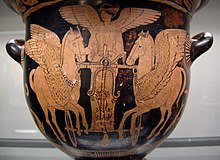
Twenty-one hymns in the Rigveda are dedicated to the dawn goddess
Sun and Moon
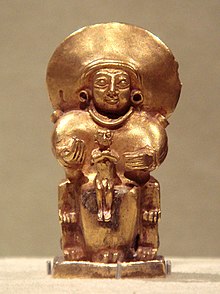
The daily course of *Seh₂ul across the sky on a horse-driven chariot is a common motif among Indo-European myths.[note 5] While it is probably inherited, the motif certainly appeared after the introduction of the wheel in the Pontic–Caspian steppe about 3500 BC, and is therefore a late addition to Proto-Indo-European culture.[125]
Although the sun was personified as an independent, female deity,[97] the Proto-Indo-Europeans also visualized the sun as the "lamp of Dyēws" or the "eye of Dyēws";[133]
Divine Twins
, New York).In most traditions, the Horse Twins are brothers of the Sun Maiden or Dawn goddess, and the sons of the sky god,
Represented as young men and the steeds who pull the sun across the sky, the Divine Twins rode horses (sometimes they were depicted as horses themselves) and rescued men from mortal peril in battle or at sea.[137] The Divine Twins are often differentiated: one is represented as a young warrior while the other is seen as a healer or concerned with domestic duties.[117] In most tales where they appear, the Divine Twins rescue the Dawn from a watery peril, a theme that emerged from their role as the solar steeds.[138][139] At night, the horses of the sun returned to the east in a golden boat, where they traversed the sea[note 6] to bring back the Sun each morning. During the day, they crossed the sky in pursuit of their consort, the morning star.[139]
Other reflexes may be found in the
Mitra-Varuna
Although the etymological association is often deemed untenable,[143] some scholars (such as Georges Dumézil[144] and S. K. Sen) have proposed *Worunos or *Werunos (also the eponymous god in the reconstructed dialogue The king and the god) as the nocturnal sky and benevolent counterpart of Dyēws, with possible cognates in Greek Ouranos and Vedic Varuna, from the PIE root *woru- ("to encompass, cover"). Worunos may have personified the firmament, or dwelled in the night sky. In both Greek and Vedic poetry, Ouranos and Varuna are portrayed as "wide-looking", bounding or seizing their victims, and having or being a heavenly "seat".[145] In the three-sky cosmological model, the celestial phenomena linking the nightly and daily skies is embodied by a "Binder-god": the Greek Kronos, a transitional deity between Ouranos and Zeus in Hesiod's Theogony, the Indic Savitṛ, associated with the rising and setting of the sun in the Vedas, and the Roman Saturnus, whose feast marked the period immediately preceding the winter solstice.[146][147]
Other propositions
Some scholars have proposed a consort goddess named *Diwōnā or *Diuōneh₂,
Nature deities
The substratum of Proto-Indo-European mythology is animistic.[103][151] This native animism is still reflected in the Indo-European daughter cultures.[152][153][154] In Norse mythology the Vættir are for instance reflexes of the native animistic nature spirits and deities.[155][page needed] Trees have a central position in Indo-European daughter cultures, and are thought to be the abode of tree spirits.[154][156]
In Indo-European tradition, the
Earth Mother
The
Weather deity
The deities generally agreed to be
From another root *(s)tenh₂ ("thunder") stems a group of cognates found in the Germanic, Celtic and Roman thunder-gods Thor, Taranis, (Jupiter) Tonans and (Zeus) keraunos.[179][180] According to Jackson, "they may have arisen as the result of fossilisation of an original epithet or epiclesis", as the Vedic Parjanya is also called stanayitnú- ("Thunderer").[181] The Roman god Mars may be a thematic echo of Perkʷunos, since he originally had thunderer characteristics.[182]
Fire deities

Although the linguistic evidence is restricted to the Vedic and Balto-Slavic traditions, scholars have proposed that Proto-Indo-Europeans conceived the fire as a divine entity called *
The name of an Albanian fire deity, *Enji, has also been reconstructed from the Albanian name of Thursday, enj-të, which is also attested in older texts as egni or a similar variant. This fire deity is thought to have been worshiped by the Illyrians in antiquity, among whom he was the most prominent god of the pantheon during Roman times.[187] In other traditions, as the sacral name of the dangerous fire may have become a word taboo,[29] the root served instead as an ordinary term for fire, as in the Latin ignis.[188]
Scholars generally agree that the cult of the hearth dates back to Proto-Indo-European times.[186] The domestic fire had to be tended with care and given offerings, and if one moved house, one carried fire from the old to the new home.[186] The Avestan Ātar was the sacral and hearth fire, often personified and honoured as a god.[29] In Albanian beliefs, Nëna e Vatrës ("the Hearth Mother") is the goddess protector of the domestic hearth (vatër).[189][190] Herodotus reported a Scythian goddess of hearth named Tabiti, a term likely given under a slightly distorted guise, as she might represent a feminine participial form corresponding to an Indo-Iranian god named *Tapatī, "the Burning one". The sacral or domestic hearth can likewise be found in the Greek and Roman hearth goddesses Hestia and Vesta, two names that may derive from the PIE root *h₁w-es- ("burning").[29][183] Both the ritual fires set in the temples of Vesta and the domestic fires of ancient India were circular, rather than the square form reserved for public worship in India and for the other gods in Roman antiquity.[191] Additionally, the custom that the bride circles the hearth three times is common to Indian, Ossetian, Slavic, Baltic, and German traditions, while a newly born child was welcomed into a Greek household when the father circled the hearth carrying it in the Amphidromia ceremony.[186]
Water deities
.Based on the similarity of motifs attested over a wide geographical extent, it is very likely that Proto-Indo-European beliefs featured some sorts of beautiful and sometimes dangerous water goddesses who seduced mortal men, akin to the Greek
A wide range of linguistic and cultural evidence attest the holy status of the terrestrial (potable) waters *h₂ep-, venerated collectively as "the Waters" or divided into "Rivers and Springs".
A river goddess *
Wind deities

We find evidence for the deification of the wind in most Indo-European traditions. The root *h₂weh₁ ("to blow") is at the origin of the two words for the wind: *H₂weh₁-yú- and *H₂w(e)h₁-nt-.[201][202] The deity is indeed often depicted as a couple in the Indo-Iranian tradition. Vayu-Vāta is a dual divinity in the Avesta, Vāta being associated with the stormy winds and described as coming from everywhere ("from below, from above, from in front, from behind"). Similarly, the Vedic Vāyu, the lord of the winds, is connected in the Vedas with Indra—the king of Svarga Loka (also called Indraloka)—while the other deity Vāta represents a more violent sort of wind and is instead associated with Parjanya—the god of rain and thunder.[202] Other cognates include Hitt. huwant-, Lith. vėjas, Toch. B yente, Lat. uentus, Ger. *windaz, or Welsh gwynt.[202] The Slavic Viy is another possible equivalent entity.[203] Based on these different traditions, Yaroslav Vassilkov postulated a proto-Indo-European wind deity which "was probably marked by ambivalence, and combined in itself both positive and negative characteristics". This god is hypothesized to have been linked to life and death through adding and taking breath from people.[203][204]
Guardian deity
The association between the Greek god Pan and the Vedic god Pūshān was first identified in 1924 by German linguist Hermann Collitz.[205][206] Both were worshipped as pastoral deities, which led scholars to reconstruct *Péh₂usōn ("Protector") as a pastoral god guarding roads and herds.[207][208][209] He may have had an unfortunate appearance, a bushy beard and a keen sight.[210][209] He was also closely affiliated with goats or bucks: Pan has goat's legs while goats are said to pull the car of Pūshān (the animal was also sacrificed to him on occasion).[209][211]
Cattle deity
Other propositions
In 1855,
Although the name of the divinities are not cognates, a horse goddess portrayed as bearing twins and in connection with fertility and marriage has been proposed based on the Gaulish
Societal deities
Fate goddesses
It is highly probable that the Proto-Indo-Europeans believed in
In Hesiod's Theogony, the Moirai are said to "give mortal men both good and ill" and their names are listed as Klotho ("Spinner"), Lachesis ("Apportioner"), and Atropos ("Inflexible").[224][225] In his Republic, Plato records that Klotho sings of the past, Lachesis of the present, and Atropos of the future.[226] In Roman legend, the Parcae were three goddesses who presided over the births of children and whose names were Nona ("Ninth"), Decuma ("Tenth"), and Morta ("Death"). They too were said to spin destinies, although this may have been due to influence from Greek literature.[225]

In the Old Norse Völuspá and Gylfaginning, the Norns are three cosmic goddesses of fate who are described sitting by the well of Urðr at the foot of the world tree Yggdrasil.[227][228][note 7] In Old Norse texts, the Norns are frequently conflated with Valkyries, who are sometimes also described as spinning.[228] Old English texts, such as Rhyme Poem 70, and Guthlac 1350 f., reference Wyrd as a singular power that "weaves" destinies.[229]
Later texts mention the Wyrds as a group, with Geoffrey Chaucer referring to them as "the Werdys that we clepyn Destiné" in The Legend of Good Women.[230][226][note 8] A goddess spinning appears in a bracteate from southwest Germany and a relief from Trier shows three mother goddesses, with two of them holding distaffs. Tenth-century German ecclesiastical writings denounce the popular belief in three sisters who determined the course of a man's life at his birth.[226] An Old Irish hymn attests to seven goddesses who were believed to weave the thread of destiny, which demonstrates that these spinster fate-goddesses were present in Celtic mythology as well.[231]
A Lithuanian folktale recorded in 1839 recounts that a man's fate is spun at his birth by seven goddesses known as the
Welfare god
The god *h₂eryo-men has been reconstructed[
Smith god
Although the name of a particular smith god cannot be linguistically reconstructed,[199] smith gods of various names are found in most Proto-Indo-European daughter languages. There is not a strong argument for a single mythic prototype.[241] Mallory notes that "deities specifically concerned with particular craft specializations may be expected in any ideological system whose people have achieved an appropriate level of social complexity".[242] Nonetheless, two motifs recur frequently in Indo-European traditions: the making of the chief god's distinctive weapon (Indra's and Zeus' bolt; Lugh's and Odin's spear and Thor's hammer) by a special artificer, and the craftsman god's association with the immortals' drinking.[102]
Love goddess
A love goddess
]Other propositions
The Proto-Indo-Europeans may also have had a goddess who presided over the
Michael Estell has reconstructed a mythical craftsman named *H₃r̥bʰew based on the Greek Orpheus and the Vedic Ribhus. Both are the son of a cudgel-bearer or an archer, and both are known as "fashioners" (*tetḱ-).[247] A mythical hero named *Promāth₂ew has also been proposed, from the Greek hero Prometheus ("the one who steals"), who took the heavenly fire away from the gods to bring it to mankind, and the Vedic Mātariśvan, the mythical bird who "robbed" (found in the myth as pra math-, "to steal") the hidden fire and gave it to the Bhrigus.[211][248] A medical god has been reconstructed based on a thematic comparison between the Indic god Rudra and the Greek Apollo. Both inflict disease from afar thanks to their bows, both are known as healers, and both are specifically associated with rodents: Rudra's animal is the "rat mole" and Apollo was known as a "rat god".[200]
Some scholars have proposed a war god named *Māwort- based on the Roman god Mars and the Vedic Marutás, the companions of the war-god Indra. Mallory and Adams reject this reconstruction on linguistic grounds.[249] Likewise, some researchers have found it more plausible that Mars was originally a storm deity, while the same cannot be said of Ares.[182]
Myths
Serpent-slaying myth
| Part of Chaoskampf or Drachenkampf |
 |
| Comparative mythology of sea serpents, dragons and dragonslayers. |
|



